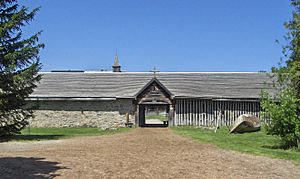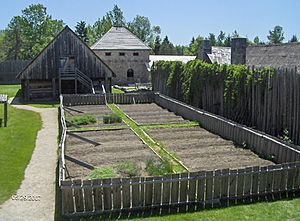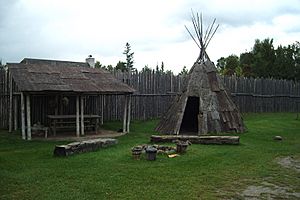Sainte-Marie among the Hurons facts for kids
 |
|
| Established | 1639 |
|---|---|
| Location | Midland, Ontario, Canada |
| Type | living museum |
| Designated: | 1920 |
Sainte-Marie among the Hurons (in French, Sainte-Marie-au-pays-des-Hurons) was a French settlement built by Jesuit missionaries. It was located in Huronia, also known as Wendake, the home of the Wendat (Huron) people. Today, this area is near Midland, Ontario. The settlement existed from 1639 to 1649. It was the very first European settlement in what we now call Ontario.
Eight missionaries from Sainte-Marie died for their faith and were later recognized as saints by the Catholic Church in 1930. In 1920, Sainte-Marie Among the Hurons became a National Historic Site of Canada. Today, you can visit a rebuilt version of the mission, which works as a living museum.
A nearby historical place, Carhagouha, shows where an earlier missionary, Father Joseph Le Caron, held the first Catholic church service in Ontario in 1615. Another important site is Saint-Louis Mission National Historic Site. This is where Jesuit missionaries Jean de Brébeuf and Gabriel Lalement were captured in 1649 when the Wendat village was attacked.
Contents
When and Why Was Sainte-Marie Built?
Sainte-Marie among the Hurons was started in 1639 by French Jesuits, Fathers Jérôme Lalemant and Jean de Brébeuf. They built it in the land of the Wendat people. This fortified settlement was a main base for Jesuit missionaries. From here, they worked with the Huron people near what is now Midland, Ontario. The mission also showed the Huron what a European community was like. It was built close to a Huron village called Quieunonascaranas, led by Chief Auoindaon.
The mission began with 18 men. When they arrived in November 1639, the priests quickly built a simple shelter. They used "cypress" pillars (likely eastern white cedar) and a birch bark roof. They used clay for the inside walls. Later, a carpenter named Charles Boivin arrived. More buildings were then constructed, including a chapel, a home for the Jesuits, a kitchen, a smithy, and other structures.
Sainte-Marie became the main Jesuit center in Huronia. From here, the Jesuits traveled among different Indigenous groups. These included the Iroquoian-speaking Huron and Petun peoples. They also visited the Algonquian-speaking Nipissing, Ottawa, and Ojibwa peoples. These groups spoke different but related languages.
What Was Life Like for Missionaries?
A small group of religious men, called donnés (meaning "given" or "offered"), worked at Sainte-Marie. They received food, clothing, and shelter for their help. The Jesuits also hired engagés, who were laborers, and non-clerical Jesuits known as "lay brothers."
The Jesuits taught the Christian Gospel to the Huron people. They often changed the stories to fit local customs and symbols. A famous example is the "Huron Carol," a Christmas hymn written by Jean de Brébeuf. A translated version of this song is still popular in Canadian churches today.
Soldiers were also present at the mission, though in small numbers. Twenty-three soldiers stayed at Sainte-Marie during the winter of 1644. However, many Jesuits did not want a military presence. They worried that soldiers would "bring the worst of Europe" with them.
The mission caused disagreements among the Wendat people. There was conflict between those who converted to Christianity and those who kept their traditional beliefs. Infectious disease also caused problems. Diseases like smallpox spread from 1634 to 1640. These diseases were brought by Europeans and their farm animals. They made the gap between traditional Wendat and the missionaries even wider.
During this time, the rivalry between the Wendat and Iroquois also grew stronger. The Wendat were weakened by their internal divisions and the many deaths from disease. Before meeting Europeans, there were about 20,000 to 25,000 Wendat people. By 1642, after the epidemics, their numbers dropped to 9,500.
War and the Missionaries' Deaths
As Iroquois attacks increased, six more soldiers were sent from France in 1649. The weakened Wendat nation was not strong enough to fight the Iroquois. The Iroquois had become stronger by trading with the Dutch to get firearms.
Eight of the missionaries were killed during the Huron-Iroquois War. These were St. Jean de Brébeuf (1649), St. Noël Chabanel (1649), St. Antoine Daniel (1648), St. Charles Garnier (1649), St. René Goupil (1642), St. Isaac Jogues (1646), St. Jean de Lalande (1646), and St. Gabriel Lalemant (1649). Because Brébeuf and Lalemant died close to Sainte-Marie, the French were able to recover their bodies. They were buried at the mission.
Why Was Sainte-Marie Burned Down?
On June 16, 1649, the missionaries decided to burn the mission themselves. They did this to prevent it from being taken over or damaged by the Iroquois in future attacks. Father Paul Ragueneau wrote about it: "We ourselves set fire to it, and beheld burn before our eyes and in less than one hour, our work of nine or ten years."
Before burning the mission, the survivors decided that Brébeuf and Lalemant would be recognized as martyrs. A shoemaker named Christophe Regnault had to remove their bones to save them as holy objects. Regnault dug up the bodies, cleaned the bones, and wrapped them in cloth. The rest of their bodies were reburied together.
The missionaries then traveled with the Wendat to Gahoendoe. There, they tried to build a second mission, designed to be easier to defend. They named it Ste. Marie II. However, a very harsh winter and constant threats from the Iroquois eventually forced the French to leave the area. They traveled back to New France, taking the bones of Brébeuf and Lalemant with them. The bones have been kept as holy relics at Ste. Marie II, which you can visit across from the Anglican church on Christian Island.
Sainte-Marie Today: A Rebuilt History
The site of Sainte-Marie was left untouched until 1844. That year, Jesuit Fr. Pierre Chazelle began the first digs to find old artifacts. Father Félix Martin continued this work in 1855. In 1940, the Society of Jesus bought the land where Sainte-Marie once stood.
In 1941, Kenneth Kidd from the Royal Ontario Museum led the first scientific digs at the site. Wilfrid and Elsie Jury from the University of Western Ontario also did more excavations. In 1954, Fr. Dennis Hegarty found the graves of Brébeuf and Lalemant.
Starting in 1964, Sainte-Marie was rebuilt as a historical site and living museum. All the buildings and their contents are copies of the originals. It is a popular place for tourists, attracting many visitors each week during the summer. Huronia Historical Parks manages the site. This is an agency of the Ontario Ministry of Tourism and Culture.
The eight missionaries who died are known as the Canadian Martyrs. They were recognized as saints by Pope Pius XI in 1930. The site next to the Martyrs' Shrine was visited by Pope John Paul II in 1984 during his trip to Canada.
On August 22, 2006, three of the rebuilt buildings were badly damaged in a fire. These were the blacksmith forge, the carpenter's workshop, and the chapel. They have all been rebuilt since then.
Images for kids
See also
- Jesuit missions in North America
- List of Jesuit sites
- Sainte Marie among the Iroquois
- Wyandot people









